Nothing adds to a garden’s enchantment quite like lush flowering vines! With their delicate tendrils, cascading leaves, and colorful blossoms, your garden will look like it belongs in a fairy tale. Whether growing wildly on their own or trained to climb arches and trellises, flowering vines are the perfect way to add both color and intrigue to your garden. So, let’s take a closer look at 20 vines that produce beautiful purple flowers!
1. Purple Morning Glory (Ipomoea purpurea)
One of the most popular vines with beautiful purple flowers is the glamorous purple morning glory. Native to Mexico and Central America, entwining morning glory vines blossom in the morning and close back up again at night. These beautiful flowers can grow 1 to 2.5 inches in diameter, with stunning colors from purple to blue or white.
However, morning glory seeds are poisonous, so be sure to keep them away from any pets or children in your home. In addition, morning glory can be potentially invasive, so you’ll need to limit them to one place in your garden. But with careful cultivation, their large and showy blooms will make an excellent addition to any garden.

Purple morning glory is also called common morning-glory and tall morning-glory.
©CoinUp/Shutterstock.com
2. Purple Nightshade (Solanum xanti)
Growing up to 8 feet, purple nightshade vines can climb any nearby objects. They branch up to 35 inches and produce beautiful flowers from February to June. Purple nightshade flowers have very small flowers that only grow to about an inch wide and look like little, tiny purple umbrellas encircling bright yellow centers.
These flowers are native to the western United States down to Northwest Mexico and Baja California. In the wild, they typically grow in coniferous forests, oak woodlands, chaparral, and other habitats. However, like many other types of nightshade plants, they are poisonous so you should be careful with these flowering vines.
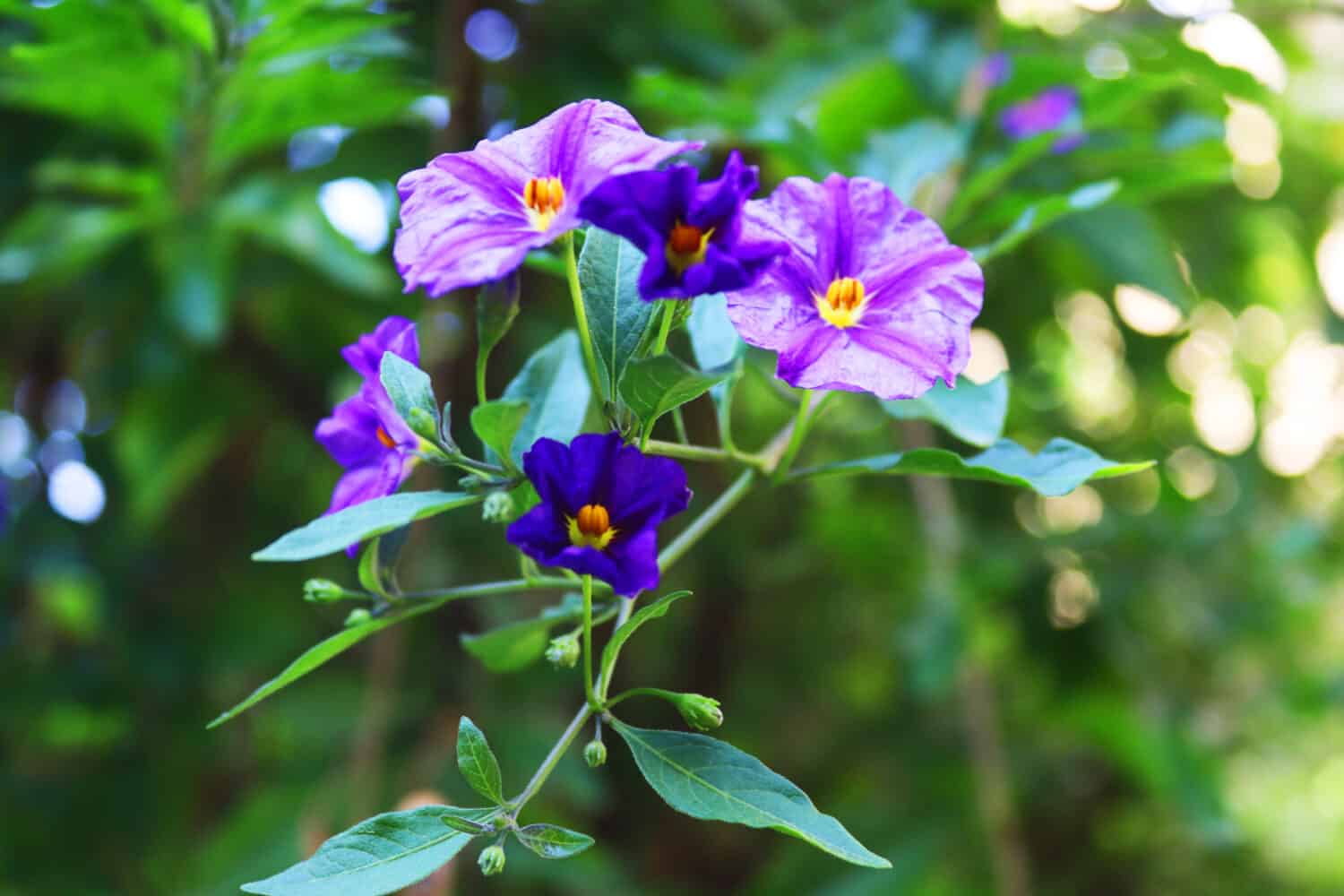
Purple nightshade also goes by chaparral nightshade and Sand Diego nightshade.
©BonaDesigns/Shutterstock.com
3. Clematis (Clematis viticella)
Another beautiful vine with purple flowers is the clematis, a member of the buttercup family (Ranunculaceae). Native to Europe, it is a deciduous plant with dark green leaves and small to medium-sized flowers that grow 2 to 5 inches in diameter. Clematis flowers come in many different colors, including purple, blue, white, and red.
These lovely vines also grow very quickly, reaching heights of 10 to 15 feet and spreading 3 to 5 feet wide. They are excellent climbing plants and can be trained to grow along vertical spaces like rock walls and fences. However, these vines are also poisonous two both animals and humans. When handling clematis plants and flowers, you should wear gloves to avoid contact dermatitis.

vines do best in well-drained, humus-rich soil in full sun or partial shade.
©iStock.com/Billy_Fam
4. Purple-Leaf Japanese Honeysuckle (Lonicera japonica ‘Purpurea’)
The dark green leaves of the purple-leaf Japanese honeysuckle have lovely purple undersides, which complement their purple-red flowers. Blooming from spring to summer, these flowers are quite fragrant.
The vine itself grows rather quickly and can reach up to 10 to 30 feet. You might need to prune it occasionally to control its growth, but overall purple-leaf Japanese honeysuckles are relatively low maintenance. Many gardeners use them to grow privacy screens or to cover an arbor.

Without support, purple-leaf Japanese honeysuckle vines can create a nice, purple ground cover.
©Jam Dastin/Shutterstock.com
5. Wisteria (Wisteria)
Growing 30 to 60 feet tall, wisteria is a very popular woody twining vine native to Asia, Iran, and North America. Its flowers cluster together in large, hanging cones along the vine, creating a beautiful canopy of sweet-smelling blossoms in the spring and early summer. Wister is a very fast-growing plant that easily adds stunning color around archways and pergolas.
However, wisteria vines are pretty heavy, so they will need plenty of support in order to grow well. In addition, it’s best to grow these not close to your house. You’ll need to make sure to regularly prune your plant to both control its growth and help it remain strong. Wisteria plants are toxic to both animals and humans.

Wisteria is one of the most beautiful vines in the world, but it is very aggressive and heavy.
©mapman/Shutterstock.com
6. Butterfly Pea (Centrosema molle)
The blossoms of the butterfly pea bloom together in clusters of blue and purple. Like its name, the plant’s pea-like blossoms have a unique butterfly shape to them. They bloom from spring to summer and are attractive to pollinators like butterflies, moths, and bees. The butterfly pea is a perennial legume that comes from South and Central America and can grow up to 10 feet.
Once established, butterfly pea vines are drought-tolerant and low maintenance. They prefer areas with full sun and well-drained soil, although they do benefit from regular irrigation. Not only are butterfly pea plants beautiful, but they also provide a good source of potassium, calcium, and protein for foraging livestock like cattle.
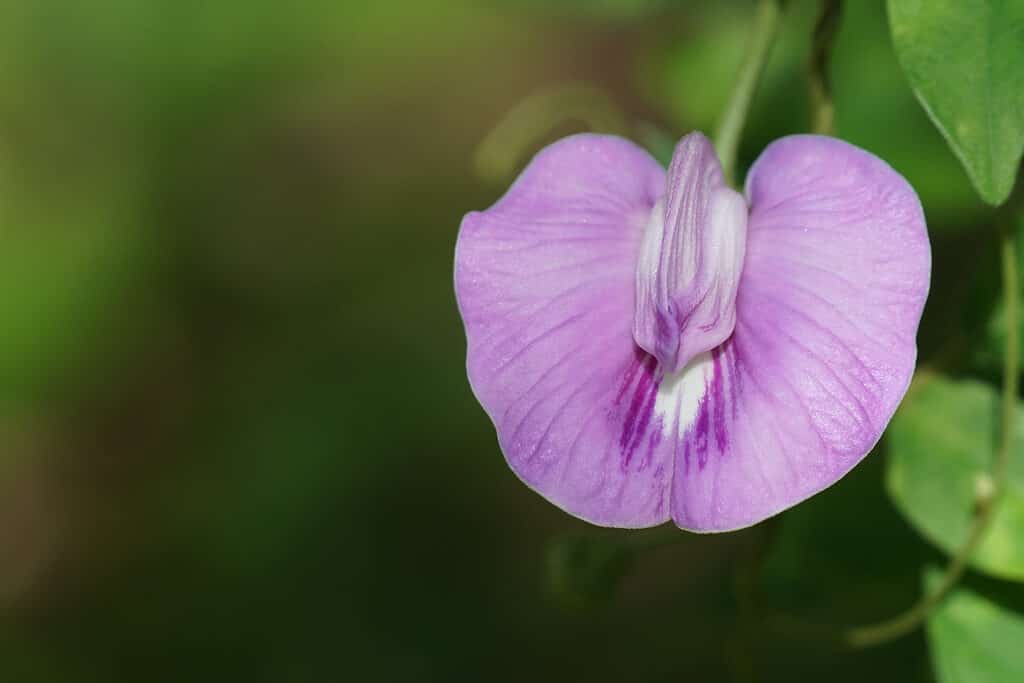
Butterfly peas are the favorites of many photographers due to their showy petals.
©Doikanoy/Shutterstock.com
7. Bougainvillea (Bougainvillea spectabilis)
Blooming from early spring through the fall, bougainvillea vines produce very tiny white or yellow flowers. However, these delicate blossoms are surrounded by large, modified purple leaves called bracts that look like flowers themselves. Bougainvillea plants grow as shrubs or woody vines up to 15 feet tall with heart-shaped leaves. They are popular plants in warm climates, both for their beautiful flower-like bracts as well as their adaptability to a variety of conditions. However, beware of the small, curved thorns under the leaf axles of these plants, as they can be painful.
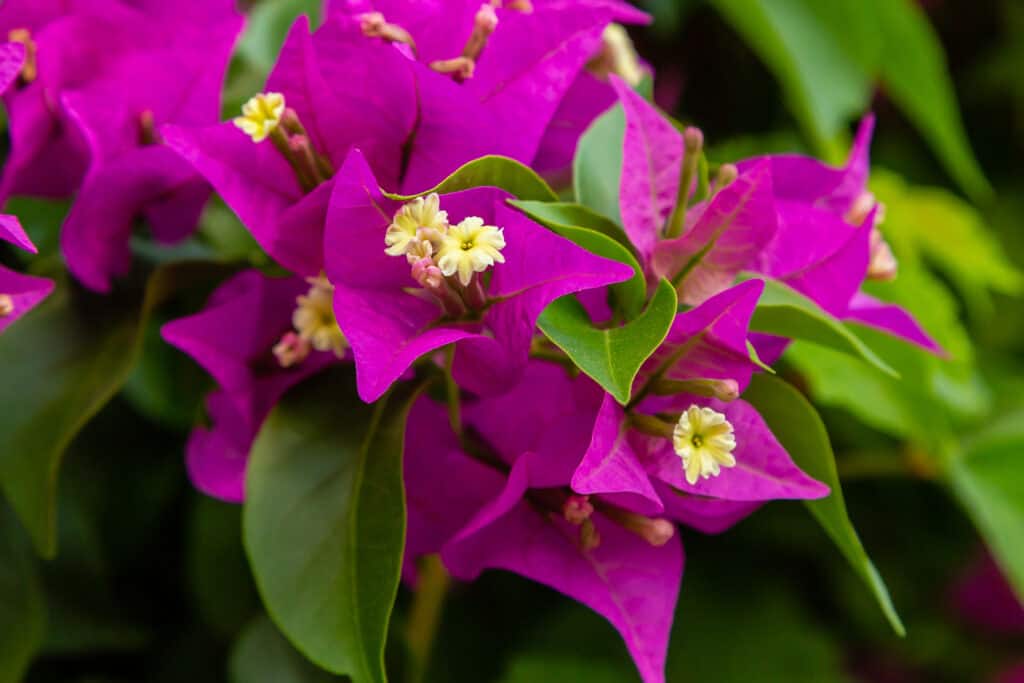
Bougainvillea plants can be grown as shrubs or woody vines.
©Flower_Garden/Shutterstock.com
8. Brazilian Dutchman’s Pipe (Aristolochia gigantea)
Native to Brazil, the Brazilian Dutchman’s pipe is a fast-growing evergreen vine that is highly toxic to humans and animals. It is also called the giant Dutchman’s pipe or the giant pelican flower due to the unique shape of its enormous and stunning purple blossoms. Instead of regular petals, these flowers have large, oddly shaped structures called calyces. The calyces open up to an incredible 6 to 12 inches wide and 1 to 2 feet tall, with a purple-maroon color covered in pink etchings like delicate scribbles along the veins.
The flowers also have a yellow-orange throat hiding inside and produce a strong and unpleasant smell that resembles rotting meat! That may not sound very appealing to us, but flies and other insects can’t resist this wonderfully stinky aroma. As they flock to the flowers, they help in pollination by transferring the plant’s pollen from one flower to another.
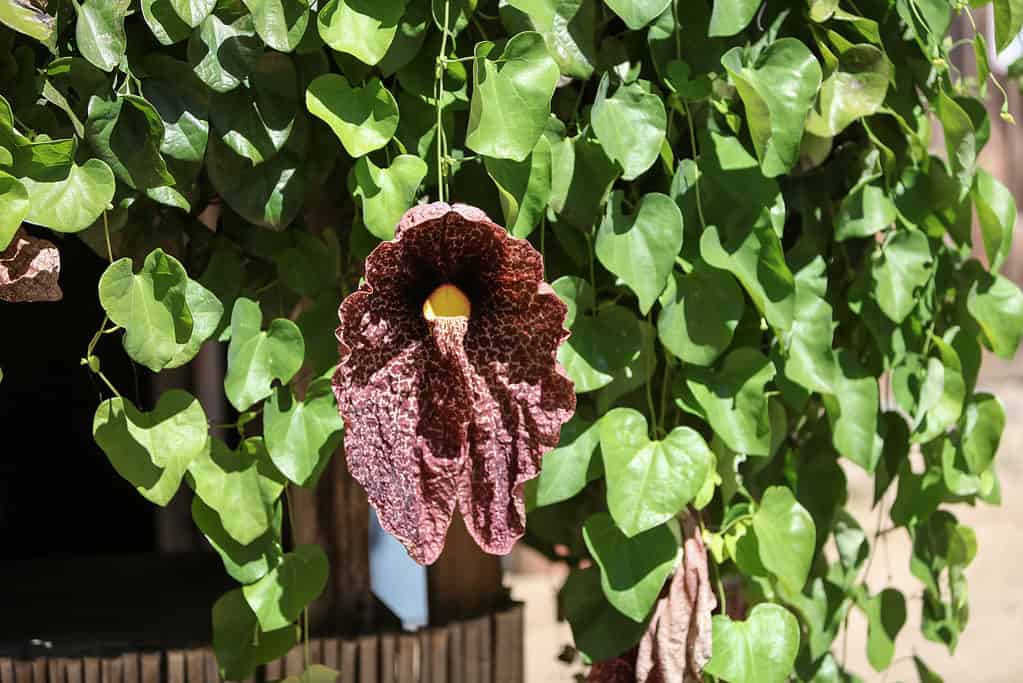
The Brazillian Dutchman’s pipe has green, heart-shaped leaves.
©iStock.com/LagunaticPhoto
9. Lavender Trumpet Vine (Clytostoma callistegioides)
Fast growing with its clinging tendrils, the lavender or violet trumpet vine can grow 15 to 25 feet or longer, with beautiful clusters of showy purple flowers. The trumpet-shaped flowers are about 3 inches wide, with beautiful violet or lavender hues. They grow on dense woody vines that can climb on just about any surface, from the walls of a house to a telephone pole. Because of that, it’s important to keep the vine in check so it doesn’t cause any damage to its support or surrounding habitat. Lavender trumpet vines are native to Brazil and Argentina but are also quite adaptable in many different growing conditions.
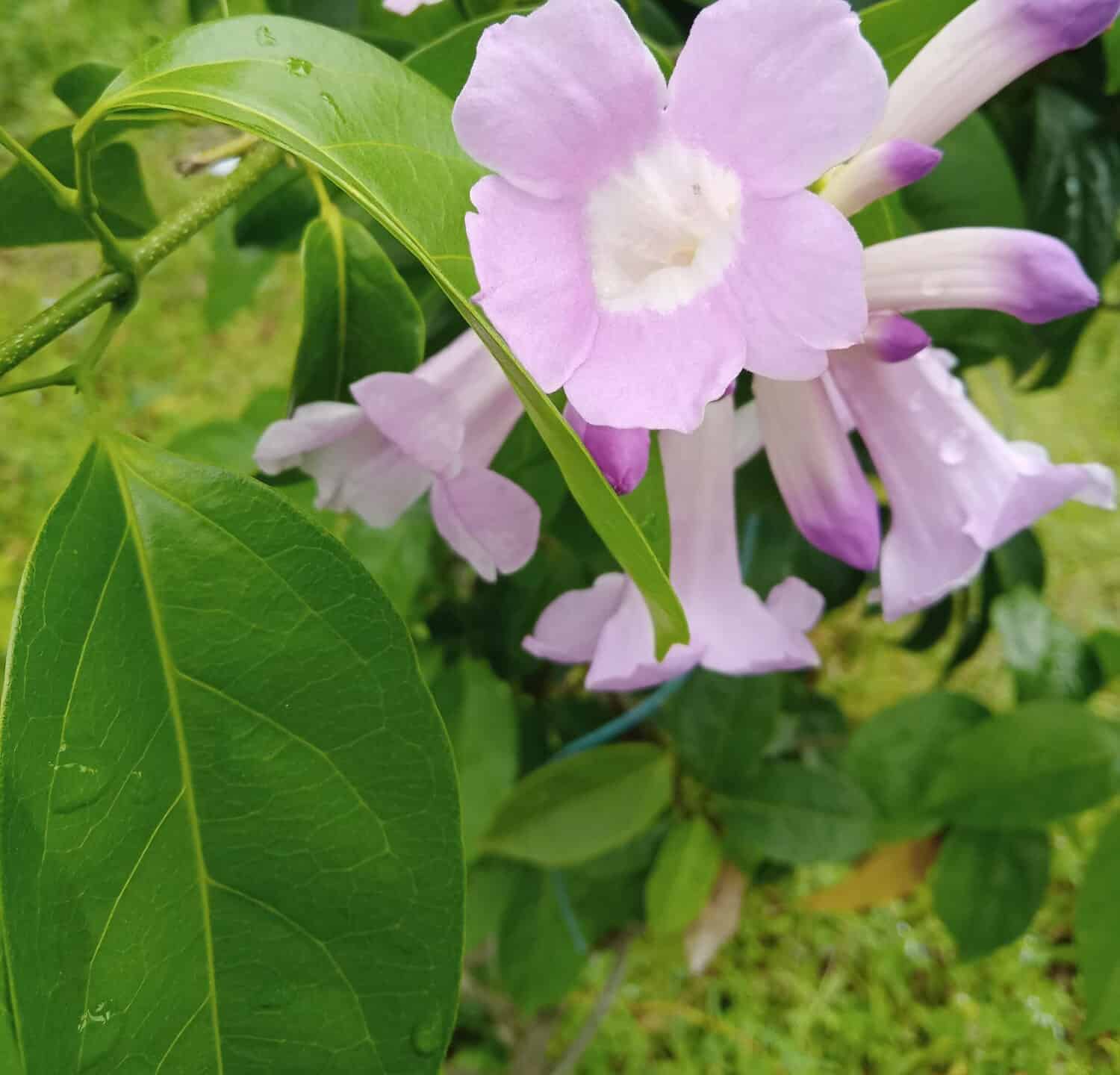
Lavender trumpet vines bloom in the late spring through the summer.
©Naeem Ahmod/Shutterstock.com
10. Chocolate Vine (Akebia quinata)
The delectable chocolate-purple flowers of the chocolate vine hang in lovely clusters and are quite fragrant — in fact, they smell a lot like chocolate! The fruit of the chocolate vine is also purple, found within a sausage-shaped pod that measures 2 to 4 inches long. Also known as the five-leaf chocolate vine or the five-leaf akebia, these delicious-looking vines are native to Japan, China, and Korea, where they grow on trees, in hedges, along forests and streams, and on mountainous slopes.
Growing 20 to 40 feet tall and 10 to 15 feet wide, the chocolate vine is a fast-growing plant that prefers moist well-drained soil and full sun to partial shade. However, these beautiful vines can be hard to control, and in some areas, they can be invasive.

Chocolate vines are not just a chocolatey-purple color, they even
smelllike chocolate!
©NataliaNM/Shutterstock.com
11. Twining Snapdragon (Antirrhinum kelloggii)
Native to North America, the twinning snapdragon (or Kellogg snapdragon) is a unique vine-like wildflower that grows in the mountain ranges and coastal hills of Baja California and California. It grows especially well in areas that have recently been burned, producing beautiful snapdragon flowers of deep purple, lavender, or indigo. These cute little wildflowers grow on slender, coiling stems on plants no more than 1 to 3 feet tall.
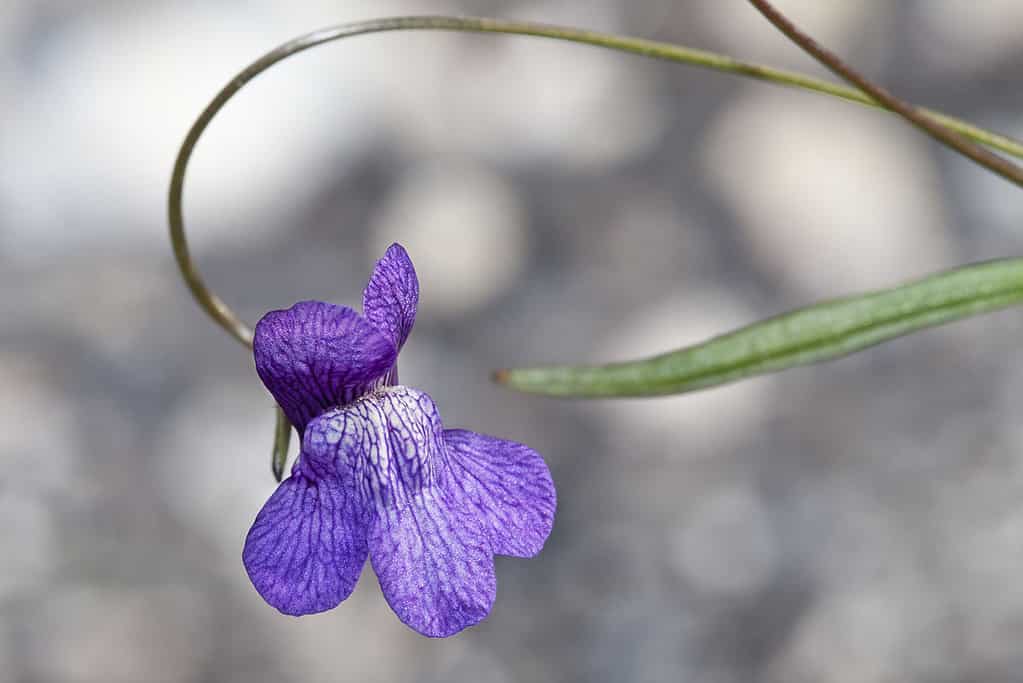
Twining snapdragons often follow wildfires and show up after a wildfire.
©Bill Bouton from San Luis Obispo, CA, USA / CC BY-SA 2.0 – Original / License
12. Maypop or Purple Passionflower (Passiflora incarnata)
You will be hard-pressed to find a flower quite as unique as the maypop vine! These large and showy blossoms are 3 to 4 inches wide with bluish-white petals and pinkish-purple sepals. There is also a white and purple crown-like structure between the petals and stamens with tons of squiggly, radiating filaments.
The maypop vine begins blooming in July and attracts bumblebees and carpenter bees. It is also called the purple passion flower, wild passion vine, true passion flower, and wild apricot. This vine grows quickly in many different types of habitats like fields, forests, and along roadsides. It also produces edible yellow-green fruits that ripen to a lovely orange-yellow color in May, which is why it is called the “maypop”.
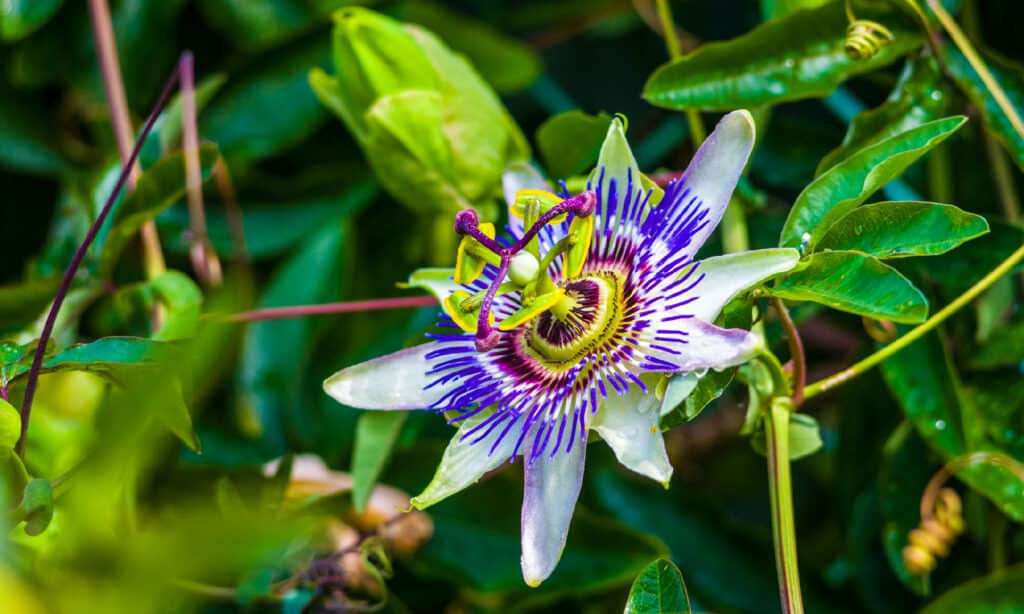
Maypop vines produce fruits with a sweet and tangy flavor.
©iStock.com/Shedu
13. Garlic Vine (Mansoa alliacea)
This tropical vine with purple flowers is native to South America and can grow up to 30 feet long. If you crush the dark green leaves, they produce a very strong fragrance — it smells like garlic, which is where the plant gets its name! Garlic vines produce beautiful lavender to white trumpet or funnel-shaped flowers that grow together in clusters. They bloom both in the spring and later on in the fall, adding bright color to your garden twice a year.
Garlic vine plants are woody and grow up towards the sun. They can get rather heavy, however, so you’ll want to ensure that whatever structure, fence, or trellis they’re growing on is sturdy enough to hold their weight. These beautiful and lush vines will thrive if they can get eight to 12 hours of direct sun each day, but they can tolerate some partial shade.

In South America garlic vine is also called
Ajo sativa,which means wild or forest garlic.
©ajisai13/Shutterstock.com
14. Queen’s Wreath (Petrea Volubilis)
Native to tropical regions in North, South, and Central America, the queen’s wreath vine produces stunning purple or violet flowers that grow in densely packed clusters like grapes. They bloom multiple times each year, but especially from February to June. The flowers are small, with a light blue or purplish color. After some time, however, the flowers fall off, leaving behind star-shaped calyces. These calyces are long, slender, and a lovely shade of purple — and are just as pretty as the petals of the actual flower!
In full bloom, Queen’s wreath vines are almost completely covered with beautiful blossoms. They thrive best in full sun but can also tolerate partial shade. Many gardeners grow these elegant vines to cover fences, gated entrances, and on trees. Purple wreath vines can grow up to 40 feet tall, but typically they are closer to 13 feet tall and spread up to 6 feet wide.

Queen’s wreath vines go by many names, such as sandpaper vine or purple wreath,
©aimpol buranet/Shutterstock.com
15. Blue Morning Glory (Ipomoea indica)
Although they are called blue morning glory, many of these beautiful flowering vines also produce stunning purple flowers as well. They are perennial plants that come back each year and grow in warm places around the world, especially in tropical and subtropical areas.
Blue morning glory vines are excellent climbers and often scale walls, slopes, and even other plants. They produce 2- to 3-inch-wide flowers with bright blue or blueish tones that transition to reddish-purple or red as they get older. Blue morning glory vines are versatile and easy to care for.
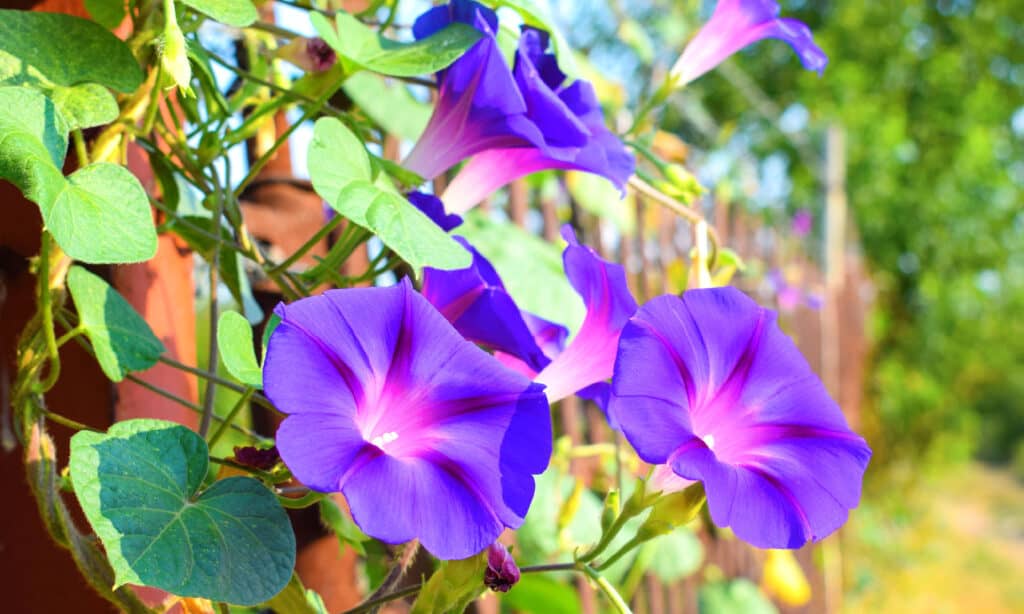
Blue morning glory vines do best in well-drained soil and full sun and are excellent climbers.
©iStock.com/Wakhron
16. Sweet Pea (Lathyrus odoratus)
With a strong and sweet fragrance, sweet pea vines can bloom for several months, providing your garden with strong pleasant scents. Originating in Southern Italy, Sicily, and the Aegean Islands, these beautiful climbing vines can grow up to 8 feet tall if they have adequate support.
In the wild, sweet pea vines produce small flowers purple flowers no more than 1.5 inches wide. However, cultivated varieties can produce other colors, like pink, white, and blue. Although their name includes the word “pea”, sweet pea vines are not edible and are toxic if ingested.

Sweet pea blossoms have a beautiful scent and are great additions to bouquets and gardens.
©Tony Baggett/Shutterstock.com
17. Corkscrew Flower (Vigna caracalla)
Also called the snail flower, snail vine, corkscrew vine, or Caracalla bean, corkscrew flowers are native to the tropical regions of South and Central America. These beautiful vines grow rapidly, producing elegant purple and white flowers that twist into spirals like corkscrews or snail shells. They bloom from July through October, with small blossoms about 2 inches long.
Corkscrew flowers are very fragrant and grow in clusters, adding both color and a lovely aroma to your garden. They are not frost tolerant, but they do tolerate humidity and heat quite well, growing well in partial shade or full sun. Corkscrew flowers attract many pollinators like butterflies and bees. They are great for arbors, fences, and trellises, and in warm climates, some gardeners even use them as ground cover.

©iStock.com/Esin Deniz
18. Perennial Pea (Lathyrus latifolius)
Native to Asia and Europe, the herbaceous perennial peas vine is also called the hardy sweet pea or everlasting pea. Its charming flowers are just .75 to 1 inch wide, growing in small groups of 4 to 11 blossoms that look like small orchids. They start off with a purple or purplish-pink color, but as they get older the flowers become lighter.
Perennial pea flowers bloom for about two months in the summer and early fall. These climbing vines can grow more than 6 feet and require full to partial sun. They are beautiful little flowers, but the plants can be hard to get rid of, and some people consider them to be weeds.
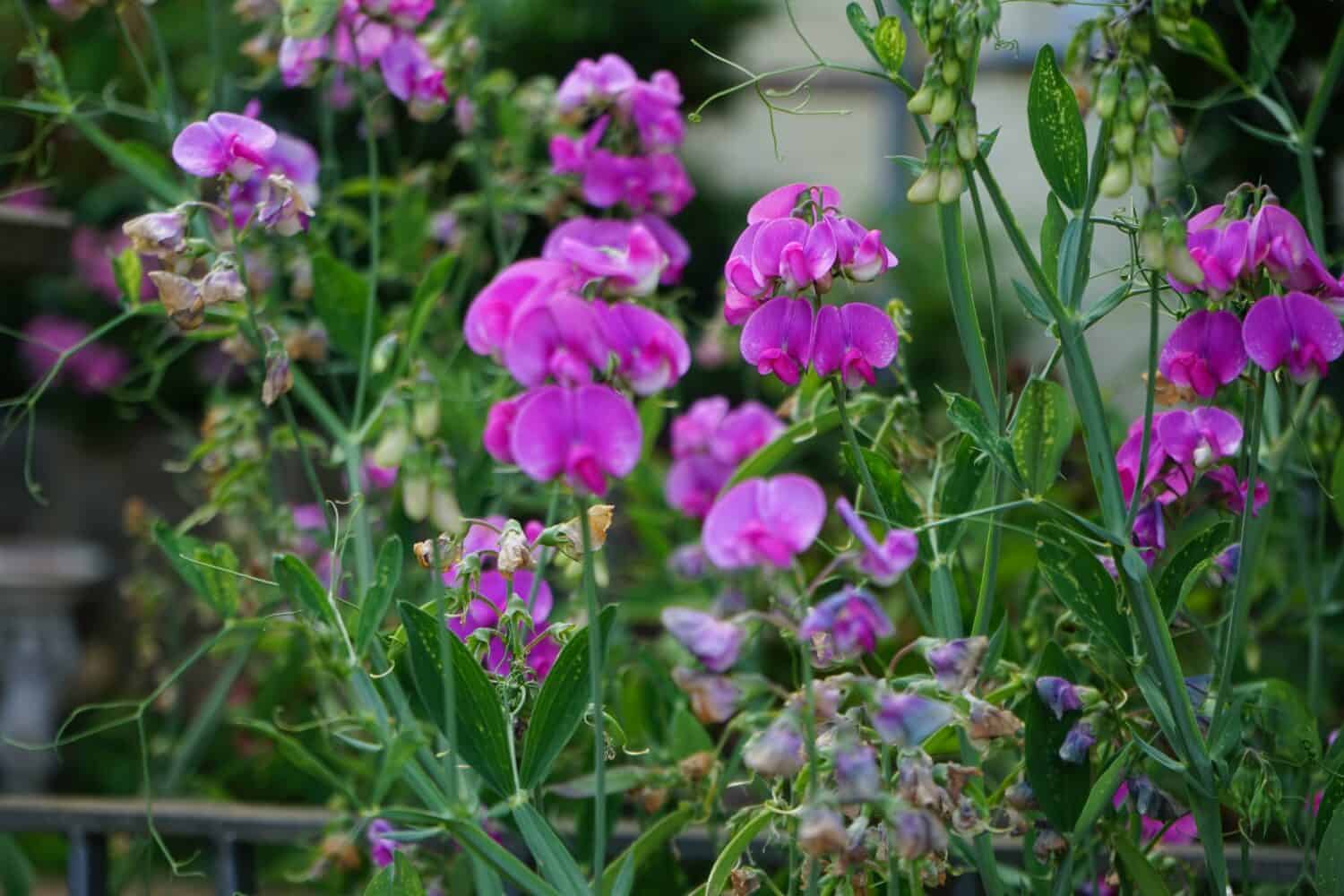
Perrenial pea vines are pollinated by bumblebees.
©crystaldream/Shutterstock.com
19. Blue Sky Vine (Thunbergia grandiflora)
Native to China, India, and Southeast Asia, this fast-growing tropical vine has large and beautiful purple or blue flowers shaped like trumpets. The flowers bloom from spring to fall, growing 3 inches wide with yellow throats or centers.
Blue sky vines can grow up to 20 feet long and are common for covering arbores, trellises, and fences. Many people also use them as privacy screens or in container gardening. These vines with beautiful purple flowers are fairly easy to care for. They prefer well-drained soil and at least six hours of full sun each day. Their fragrant flowers also attract pollinators like hummingbirds and butterflies.
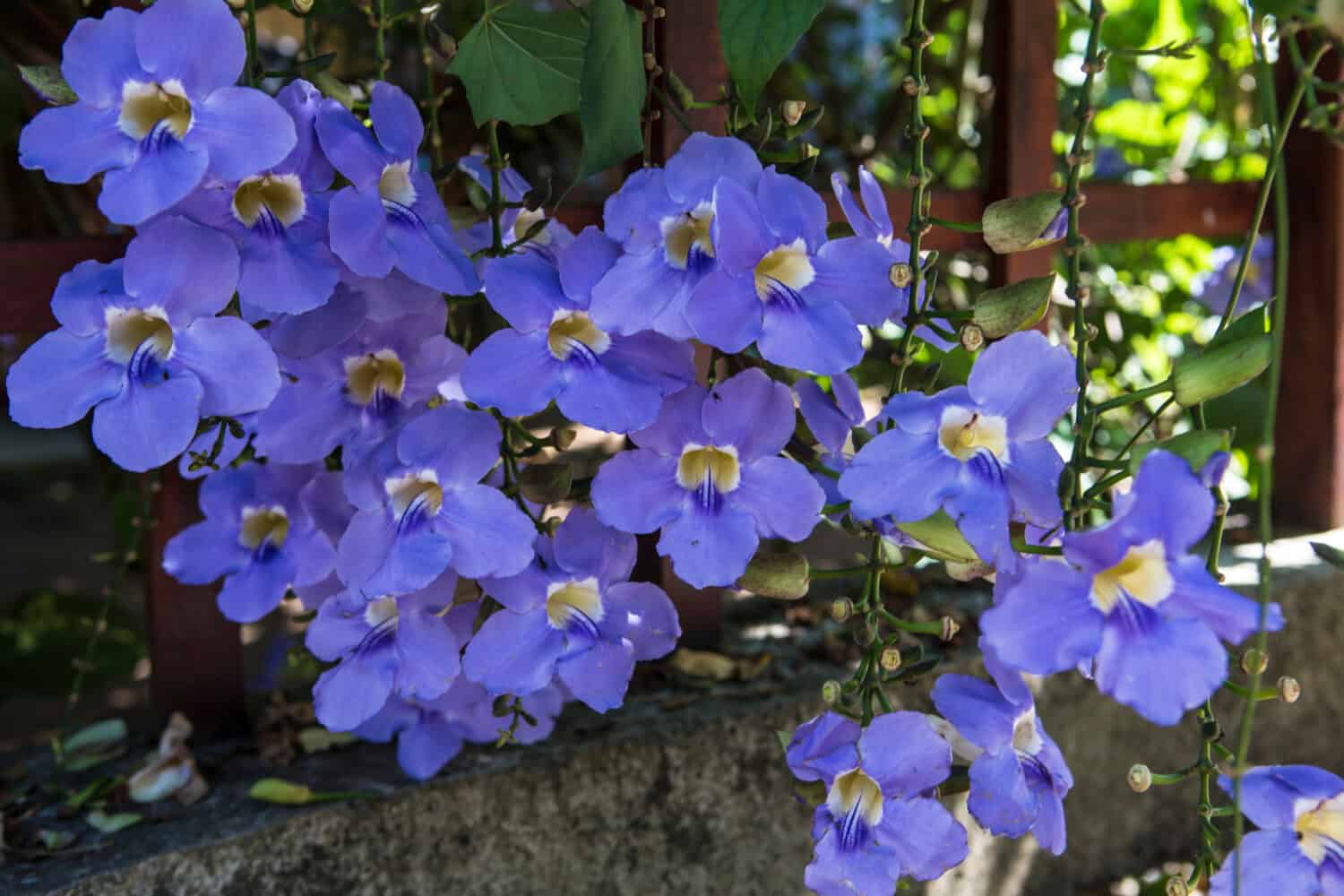
Names for these beautiful periwinkle flowers include blue sky vine, clock vine, and blue skyflower.
©limipix/Shutterstock.com
20. Hyacinth Bean Vine (Lablab purpureus)
Our last vine that produces beautiful purple flowers is the hyacinth bean vine, an annual plant native to tropical regions of Asia and Africa. These plants go by many different names including Egyptian beans and lablab beans, and can grow up to 15 feet long. They are popular for covering arbors, trellises, and fences. Some gardeners also grow them as ornamental plants and use them in container gardening.
Hyacinth bean vines produce beautiful purple flowers that measure about 1 inch wide. These small but stunning flowers bloom in clusters from summer to fall, adding a sweet and honey-like fragrance to your garden. Later they produce 3-inch-long green or purple seed pods that become brown when ripe. Many parts of the hyacinth bean vine are commonly used in various dishes. The seed and bean pods are toxic unless cooked correctly, but the leaves and flowers are edible raw.
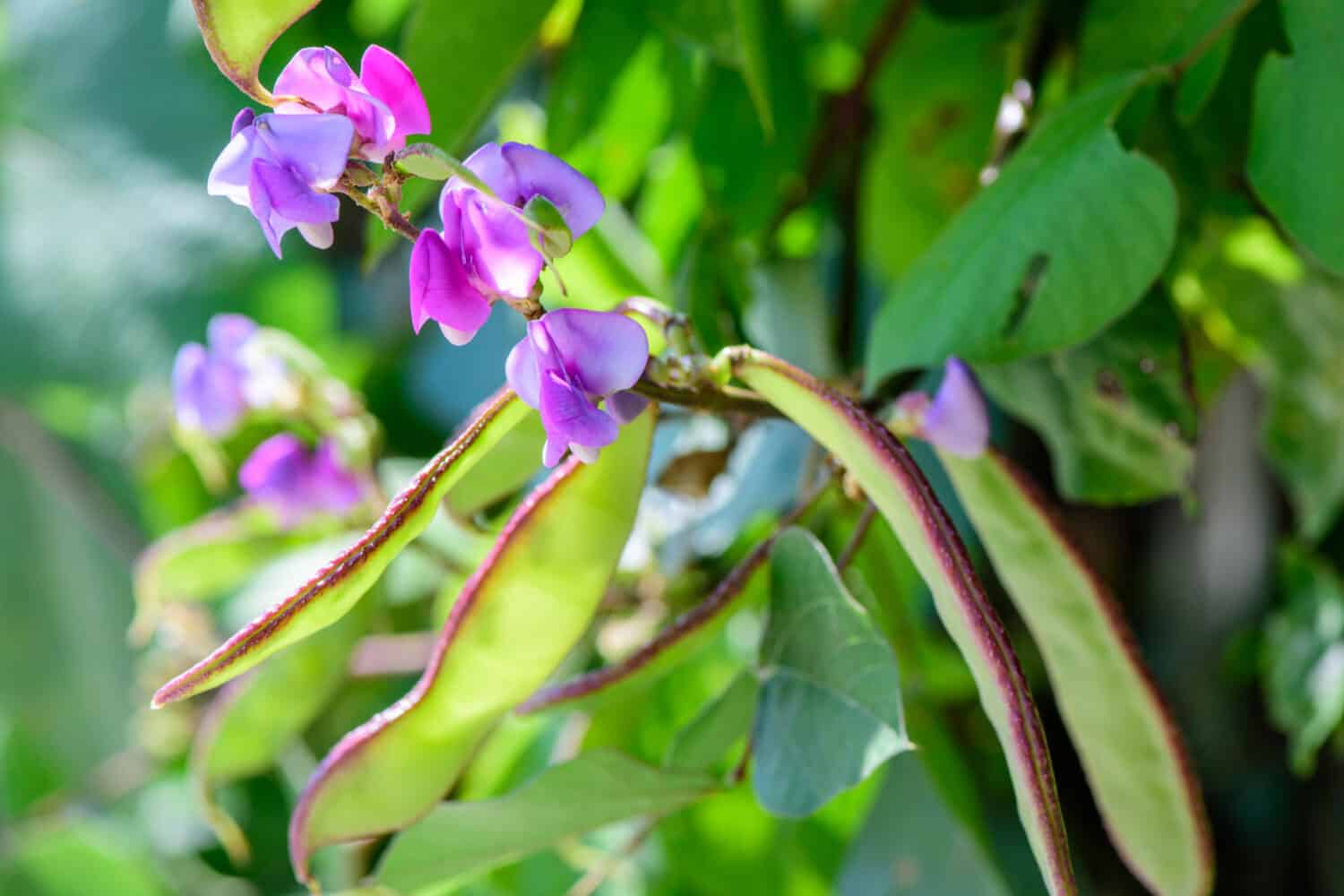
In Asia, Africa, and the Caribbean, hyacinth bean vines are sometimes grown as food, forage, and silage.
©pisitpong2017/Shutterstock.com
Summary of 20 Vines That Produce Beautiful Purple Flowers
| Common Name | Scientific Name |
|---|---|
| Morning Glory | Ipomoea purpurea |
| Purple Nightshade | Solanum xanti |
| Clematis | Clematis viticella |
| Purple-Leaf Japanese Honeysuckle | Lonicera japonica ‘Purpurea’ |
| Wisteria | Wisteria |
| Butterfly Pea | Centrosema molle |
| Bougainvillea | Bougainvillea spectabilis |
| Brazilian Dutchman’s Pipe | Aristolochia gigantea |
| Lavender Trumpet Vine | Clytostoma callistegioides |
| Chocolate Vine | Akebia quinata |
| Twining Snapdragon | Antirrhinum kelloggii |
| Maypop or Purple Passionflower | Passiflora incarnata |
| Garlic Vine | Mansoa alliacea |
| Queen’s Wreath | Petrea Volubilis |
| Blue Morning Glory | Ipomoea indica |
| Sweet Pea | Lathyrus odoratus |
| Corkscrew Flower | Vigna caracalla |
| Perennial Pea | Lathyrus latifolius |
| Blue Sky Vine | Thunbergia grandiflora |
| Hyacinth Bean Vine | Lablab purpureus |
The photo featured at the top of this post is © aimpol buranet/Shutterstock.com
Thank you for reading! Have some feedback for us? Contact the AZ Animals editorial team.







